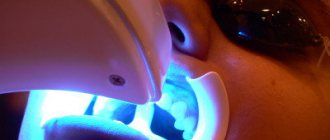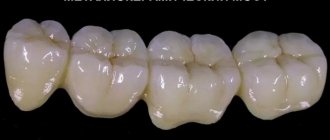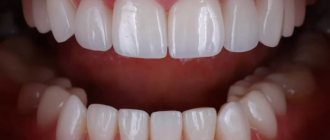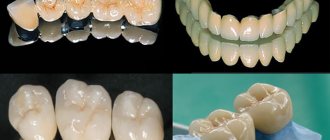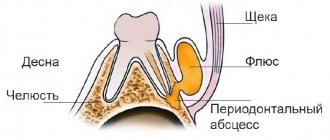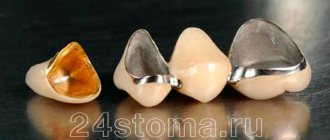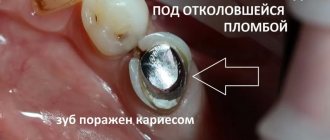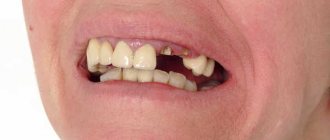Restoring part of a “dead” tooth with a filling
Before the restoration begins, endodontic treatment (canal treatment of the tooth) is carried out.
If the “nerve” was removed previously, the dentist will check the quality of the root canal treatment and, if necessary, perform re-treatment. We talk about the complexity of endodontic treatment in the article Why it is impossible to give a 100% guarantee for tooth root canal treatment.
If less than 50% of the crown part of the tooth is destroyed, the lost part can be qualitatively restored using composite filling materials.
Modern filling materials allow the dentist to accurately select the color and transparency of the part of the tooth being restored, to recreate the surface structure and anatomical shape, ensuring the correct bite and contact points with neighboring teeth.
Restoring a tooth with a filling requires the dentist to have a good knowledge of dental anatomy and the skill of a sculptor.
The filling will last 5–7 years
What affects the service life of a filling, when and why it will require replacement, you will learn from the article “Why change an old filling if everything is fine and the tooth is not bothering you?”
When salvation is a crown
A dental inlay is a way to save a tooth when it is not possible to fill it. If the damage is significant, then a filling or inlay will not help; more reliable protection will be required - a crown
.
Modern designs are durable and help maintain quality of life when 50% or more
of tooth tissue is lost.
Restoring a tooth with a crown (the price is calculated depending on the chosen material) is reliable protection against recurrent caries. Microparticles of food do not get under the crown, pathogenic microflora do not penetrate, and there is no violation of the marginal seal.
Ceramic, metal-ceramic or zirconium crowns on a tooth will become a reliable covering for the thinned, fragile walls of a natural tooth and will protect them from chipping or breaking.
Modern dentistry makes it possible to bring the shade of the crown as close as possible to the natural shade of the enamel, so the presence of the structure is almost invisible. Installing crowns on chewing teeth is an opportunity not to limit your diet, to eat familiar foods without fear of destruction of the teeth.
Restoring a “dead” tooth with a crown
If more than 50% of a part of a tooth is destroyed by the crown, it is not recommended to restore the lost part with a filling and the dentist will suggest installing a crown. Why does the volume of the part being restored influence the choice of a crown?
Over time, the composite material from which the filling is made gives vertical and horizontal shrinkage, as a result of which the connection of the antagonist teeth into the bite and the distance between adjacent teeth changes.
What problems does shrinkage of the filling lead to are described in detail in the article Why change an old filling if everything is fine and the tooth is not bothering you?
Here we will give just one example: shrinkage of the filling can lead to an increase in the load on the walls of the tooth, which over time will cause them to chip. If the crack goes under the gum (root crack), all that remains is to remove the tooth, and its restoration will require the installation of an implant or prosthetics with support on the adjacent teeth.
Unlike a filling, which is made by a dentist in one oral visit, a crown is made from impressions in a dental laboratory, so it better recreates the anatomical shape and color of the tooth. A crown is stronger than a filling and protects the tooth well from further destruction. When installing a crown, only a small layer of cement with which it is glued shrinks.
Most often, orthopedic dentists offer crowns made of metal ceramics or zirconium dioxide. We talk about choosing crowns in the article How does an orthopedic dentist decide which crown is right for your case?
The crown will last 10–15 years, but may require replacement, most likely for aesthetic reasons: receding gums lead to exposure of the edge of the crown. The edge of the metal-ceramic crown is especially noticeable on teeth in the “smile zone” (the first 5–6 teeth on each side).
A filling cannot be crowned
Many patients are still wildly afraid of crowns, and persistently ask for another filling to solve the problem.
Our doctors encounter such requests in 70% of consultations. The doctor, of course, can take into account the patient’s request and give him a filling that is good, reliable, and of high quality.
But other statistics show that patients who insist on having a filling installed return to the clinic as soon as possible, but for inlays and crowns.
There are many cases when the wall of a “dead” tooth, restored by filling, breaks off, and the chip goes under the gum, and this leads to tooth loss or removal! In most such cases, the tooth can be saved by protecting it with a crown in time.
As a result, it would be possible to avoid wasting time on visits to the doctor, save nerves and money, if you take into account the recommendations of the attending physician in a timely manner.
Using our patient as an example, let’s consider this situation.
The use of pin and stump inlays when restoring “dead” teeth
At the beginning of the article, we said that removing the nerve (pulp) deprives the tooth tissue of recharge. In addition to deteriorating the adhesion of dental materials, removing the nerve makes the tooth tissue dry and brittle, and the expansion of the canals during their treatment further weakens the tooth walls.
To make the roots of the tooth stronger, before restoring the tooth, reinforcement of the roots is performed with fonts.
If the supragingival part of a tooth is completely destroyed, then pin-and-stump inlays manufactured in a dental laboratory are used to create a tooth stump, on which a crown is then installed.
Now let’s look at what options there are for restoring “living” teeth.
Restoring teeth using root veneers
In orthopedics, there are unique possibilities for restoring teeth in cases where only one root remains of a tooth. You must immediately understand that the root tissue of the teeth must be healthy - this is the main condition for 100% tooth restoration. Look at the photo to see what we are talking about - caries-affected tissues are removed and ground down to healthy tooth tissues:
In such cases, veneers with the root part
:
And this is how beautifully, and most importantly, you can reliably restore your teeth:
Patients who encounter such technologies for the first time experience a wow effect, and their smile is not only restored, but becomes incredibly beautiful:
By the way, this clinical example can be viewed in more detail HERE
Restoration of front teeth with veneers
Installing veneers is the best option for restoring front teeth.
A veneer is a thin ceramic plate made from an individual impression in a dental laboratory. Its installation requires minor grinding of the tooth and covers the front surface and cutting edge of the tooth. Veneer - ideally conveys the “pattern” of the tooth surface and matches the color of natural teeth, is not stained by food and lasts more than 10 years.
A veneer can be broken under heavy chewing load, so teeth covered with veneers require a measured load and this type of restoration is not suitable for lateral (chewing) teeth.
If the front tooth has significant damage and the nerve has probably already been removed, the tooth should be restored with a crown.
Advantages of extension with filling material
The tooth is built up with photopolymer material if caries has “eaten” less than 1/3 of the tissue. A small extended piece looks aesthetically pleasing and does not catch the eye.
Filling a large defect is also acceptable, but after 3-4 years the filling will have to be changed because it does not strengthen the crown of the tooth. If the cavity is large and a filling is placed in the tooth, it may crack and have to be pulled out. Therefore, a crown is a winning option in 4 out of 5 cases.
Features of crowns
The advantages of crowns include:
- Hypoallergenic. Materials are used that do not cause allergies and are not rejected by the body.
- Reliability. The materials are very durable and can withstand high chewing loads.
- Naturalness. Modern crowns are difficult to distinguish from teeth. They have a translucent effect, like natural enamel.
- Maintaining appearance. Zirconium crowns do not absorb dyes. There is no need to follow a special diet.
As for the disadvantages, they also exist.
Before installing a crown, you need to consider the following:
- From the moment of preparation until the crown is fixed, it can take about 3 weeks.
- The tooth needs to be ground down to remove some of the healthy enamel.
- Installing a crown costs more than filling. However, in the end, the procedure may turn out to be more profitable due to the long service life.
How to place a crown on an implant?
A crown can be placed not only on a tooth, but also on an implant. This allows you to restore lost teeth without grinding down healthy units in the rows. Crowns on implants are durable, aesthetic, and visually indistinguishable from natural teeth.
Before placing a crown on an implant, an artificial root implantation procedure is performed. As soon as the implant takes root, an abutment is placed on it, and then a crown. Putting a crown on an implant will be more expensive than conventional prosthetics, but the price of the service is fully compensated by the impeccable aesthetics and long service life of both the implant and the crown.
Making crowns
Crowns are made from an impression that is taken from the prepared teeth. To obtain this impression, the orthodontist will use a special plastic mass. Based on the impression taken, the laboratory will first make a plaster model of the prosthesis, and then a crown, which will be placed on the tooth.
Modern dental crowns are made from different materials: metal, ceramic, metal-ceramic and zirconium. The timing of the production of the prosthesis will depend on what kind of crown it is decided to place on the tooth. Crowns made of ceramics and metal-ceramics take the longest to produce. So that a person does not have to walk without a tooth during the entire time of making the crowns, a temporary plastic prosthesis is put on the tooth.
IMPORTANT: Temporary plastic crowns help hide a defect in the dentition; a person will not have to be embarrassed by the absence of a tooth and experience stress for this reason. Also, temporary dentures help protect a ground and therefore weakened tooth from the negative effects of environmental factors and bacteria.
Differences
Typically, crowns are much stronger than fillings. The only exceptions are structures made of plastic.
If the filling material falls out, the tooth will require repeated treatment, which cannot be said in the case of an installed crown, which can be reinstalled at any time in the absence of external damage.
Fixing crowns takes much longer than the filling process.
Crowns allow you to ideally restore the lost shape of a tooth, while using a filling it is not always possible to achieve this result.
How to care for crowns -
If you have single crowns on your teeth, regular floss, brush, and toothpaste after each meal will usually be sufficient. However, when it comes to bridges, hygiene difficulties may arise. After all, the latter have an intermediate part (which restores the lost tooth), and it is under it that food debris accumulates, which is difficult to remove.
Therefore, for patients with bridges, as well as with periodontal pockets in the crown area, we recommend using special irrigators (Fig. 10), which allow you to clean hard-to-reach areas of the oral cavity from food debris and accumulation of soft plaque. These devices create a pulsating stream of high-pressure water, which is supplied through a special nozzle.
Crown service life
Patients who plan to get a crown are often interested in its useful lifespan. The service life of a crown placed on a tooth will depend on a number of factors:
- Crown material and technology;
- The patient’s compliance with all doctor’s recommendations for crown care;
- Quality of preparation of teeth for prosthetics.
The last factor is of fundamental importance: if mistakes are made during the preparation and manufacturing of the crown, the crown will not last long, and undesirable complications may arise, due to which the crown will have to be removed and re-installed on the tooth. For these reasons, you need to very carefully choose the clinic where you plan to treat and restore your teeth! Remember that the worst type of saving is saving on your own health!
The crown must be placed in a well-equipped dental clinic, staffed by experienced orthopedic doctors and dental technicians. The clinic must use the most modern technologies for diagnostics, treatment and dental prosthetics; only this approach to the choice of dentistry guarantees high quality treatment!
Grinding a tooth for a crown
Before placing a crown on a tooth, the tooth must be ground to the thickness of the future prosthesis. This procedure in professional dentistry is called “preparation”. The enamel of the tooth is ground down with a drill and during the treatment the doctor will give the tooth a shape that will allow the crown to be placed firmly and tightly.
IMPORTANT: Grinding of live teeth can be quite painful, so local anesthesia must be administered before performing this procedure. If the tooth was depulped before grinding, local anesthesia may not be used, the procedure will not cause pain.
When preparing teeth, a layer of tissue is removed from the tooth before placing a crown. The thickness of the layer will depend on how thick the crown will be. A minimal layer of tissue is removed from the teeth for cast crowns; a significant layer of tissue must be removed from the tooth if it is decided to install ceramic or metal-ceramic crowns. On average, during the grinding process, about 2.5 mm of tissue is removed from a tooth on each side.
As a result of tooth preparation, a core base (stump) is obtained, on which the doctor will place a crown.
Tooth restoration with filling
When the crown of a tooth has collapsed, what is more rational - modern prosthetics or restoration with durable filling materials?
If the molars are damaged, the doctor suggests restoring their functionality by installing a pin that strengthens the overall restoration. As a result, the desired effect will be achieved: you can chew again (but do not forget that overload is prohibited), the aesthetics of the molar will be quite acceptable. The tooth will look aesthetically pleasing - there are no external defects, the shape is even and anatomically justified.
Save a tooth with a pin or module
If a tooth breaks off and the natural crown is significantly damaged, a pin can again come to the rescue. With its help, you can strengthen the base and cover the tooth with an artificial crown or build it up with a polymer material.
The pins are made of both titanium and polymer; the alloy is biocompatible with body tissues and does not cause a negative reaction from tissues. The metal is durable - parts of the aircraft landing gear are made from it, so it can cope with chewing loads without problems. Installation of the structure is recommended when:
- Only parts of the real crown of the tooth remain (half or more is destroyed).
- The dentin is so damaged that the usual filling will not hold. Restoration with durable materials is required.
- It is necessary to restore the tooth under the covering of a prosthesis - permanent or removable.
The rod cannot be used if the root is destroyed (there is no support), if there is inflammatory gum disease, or if there is a cyst or granuloma under the problematic root.
Cerec modules
today it is much more effective than pins both in compatibility with the tooth and in strength.
And the main thing is the speed of restoration: any crown part of a tooth can be restored with the Cerec module in just 1-1.5 hours
.
The main condition for restoration is an intact tooth root. And, of course, the restrictions are the same as for pins: the presence of inflammation, cysts or granulomas under the problematic root is a direct contraindication. First, you need to eliminate these problems, and only then approach tooth restoration with the Cerec module.
Another interesting trend is the replacement of previously installed restoration pins with Cerec modules. This is due to the fact that pins still have their disadvantages, which can lead to tooth destruction, as shown in this video:
Tooth restoration with filling
Before starting the procedures, an examination is carried out - an x-ray or CT scan is performed. After making sure that there are no contraindications and the presence of a healthy root, the doctor decides to install a pin. When tooth damage is not critical - 30-40%, then restoration of the unit with filling compounds is completely justified:
- The pin is carefully mounted into the root canal, and cementation is performed.
- Next, the photopolymer composition is applied layer by layer. A filling is formed that replicates the physiologically justified tooth crown.
- The material is curing. The dentist polishes the surface, giving it a natural look.
In appearance, such a molar does not differ from neighboring teeth. But over time, the filling may change color.
If 2/3 of a tooth is damaged, installing a pin will help create a basis for strengthening the artificial crown. Filling is possible, but it is irrational - the tooth is fragile and will not withstand significant loads. Careless handling can provoke further breakdown of the unit, which can lead to complications. Therefore, in case of severe damage, placing a crown on a tooth is considered a reliable method of restoration.
